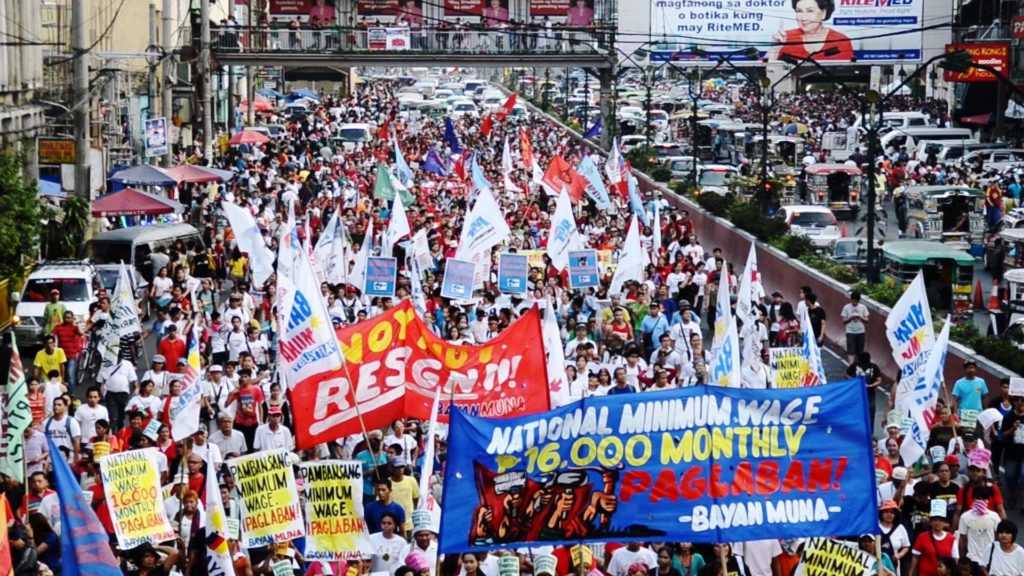
Last Friday, May 1, workers around the world protested, demonstrated, marched, locked arms, sang, and celebrated workers’ power. In many places, the manifestations continue. In many places, from Baltimore to Toronto to Tel Aviv to Durban to Melbourne, workers challenged the exploitative commerce the intersection of race, ethne, gender, age and class: Black Lives Matter! In Bujumbura, Burundi, workers protested President Pierre Nkurunziza’s attempt to seek a third term in office, a violation of both the Constitution and the peace accords. They marched to honor the labor of democracy and a just peace, as did workers in Turkey, who were attacked by the police. The list goes on, including France, Greece, Germany, Italy, Ukraine, Russia, Iran, India, Bangladesh, South Korea, Indonesia, Malaysia, Japan, Cambodia, Philippines, Taiwan, Singapore, Colombia, Guatemala, Panama, Peru, Venezuela, Brazil, and Cuba.
But who is a worker, and who is not? Who labors and is not included in the category of worker? Women. In particular women, and children, engaged in unwaged labor, and this sector is on the rise globally. Intimately linked to this group are the unemployed. Who is a worker and is not included in the “workers’ movement.”
On January 14, 1998, several hundred unemployed worker activists and their supporters entered into the “hallowed halls” of the Ecole Normale Supérieure in Paris, and started a five-day occupation, which captured the imagination of much of the world. The unemployed workers had had enough. Assez! In fact they were members of an organization called Agir ensemble contre le chômage! Acting together against unemployment! They were known as AC! which is a homonym for Assez! Enough!
The occupation involved middle-aged unemployed and precarious workers, young anarchists, and others. It also involved hundreds of riot police, who promptly occupied the surrounding streets and then neighborhoods.
At the time, along with AC!, there was the National Movement of Temporary and Unemployed Workers, founded by Jacqueline Maman and focusing on women workers, especially in neighborhoods where North African workers lived. When Maman found that she didn’t qualify for unemployment benefits, despite having paid into the benefits system, she went to work: ”The unions and the employers administer the unemployment insurance and pension system, but people who are permanently out of work have no voice in how the money is spent. The unemployed should sit on those boards. But the union leaders don’t even want to know about the likes of us.”
The likes of us.
When sociologist and leading public intellectual Pierre Bourdieu went to speak to the chomeurs, he praised the activists for their extraordinary work. He noted the importance of the movement’s very existence: “The first conquest of the movement is the movement itself, its very existence: it pulls the unemployed and with them all insecure workers, whose number increases daily, out of invisibility, isolation, silence, in short, out of non-existence.”
The lesson of the chomeurs, then as now, is the importance of solidarity in the context of movement building: “Unemployment and the unemployed haunt work and the worker. Short-term, part-time and temporary workers of every category … all live in fear of unemployment … The mobilization of those whose existence is undoubtedly the main factor in a loss of militancy is the most extraordinary encouragement to mobilization, to the rejection of political fatalism … The unemployed are reminding all workers that their interests are bound up with those of the unemployed; that the unemployed whose existence weighs heavily on them and on their working conditions are the product of a policy; that a mobilization capable of overcoming the frontiers that exist … between workers and non-workers and the frontiers between all the workers and non-workers of one country and the workers and non-workers of every other country could counter the policy which can mean that the non-workers can force silence and resignation on those who have the dubious `privilege’ of a more or less precarious employment.”
Workers and non-workers of the world unite! We have nothing to lose but our fear and the bosses’ violence. Workers and non-workers are linked in an embrace so fierce that they become one. From Haymarket Square to the Ecole Normale to the squares and plazas all over the world today … the State brings riot police, the workers bring themselves. Amandla! A luta continua!
(Image Credit: Buhay Manggagawa / Global Voices)